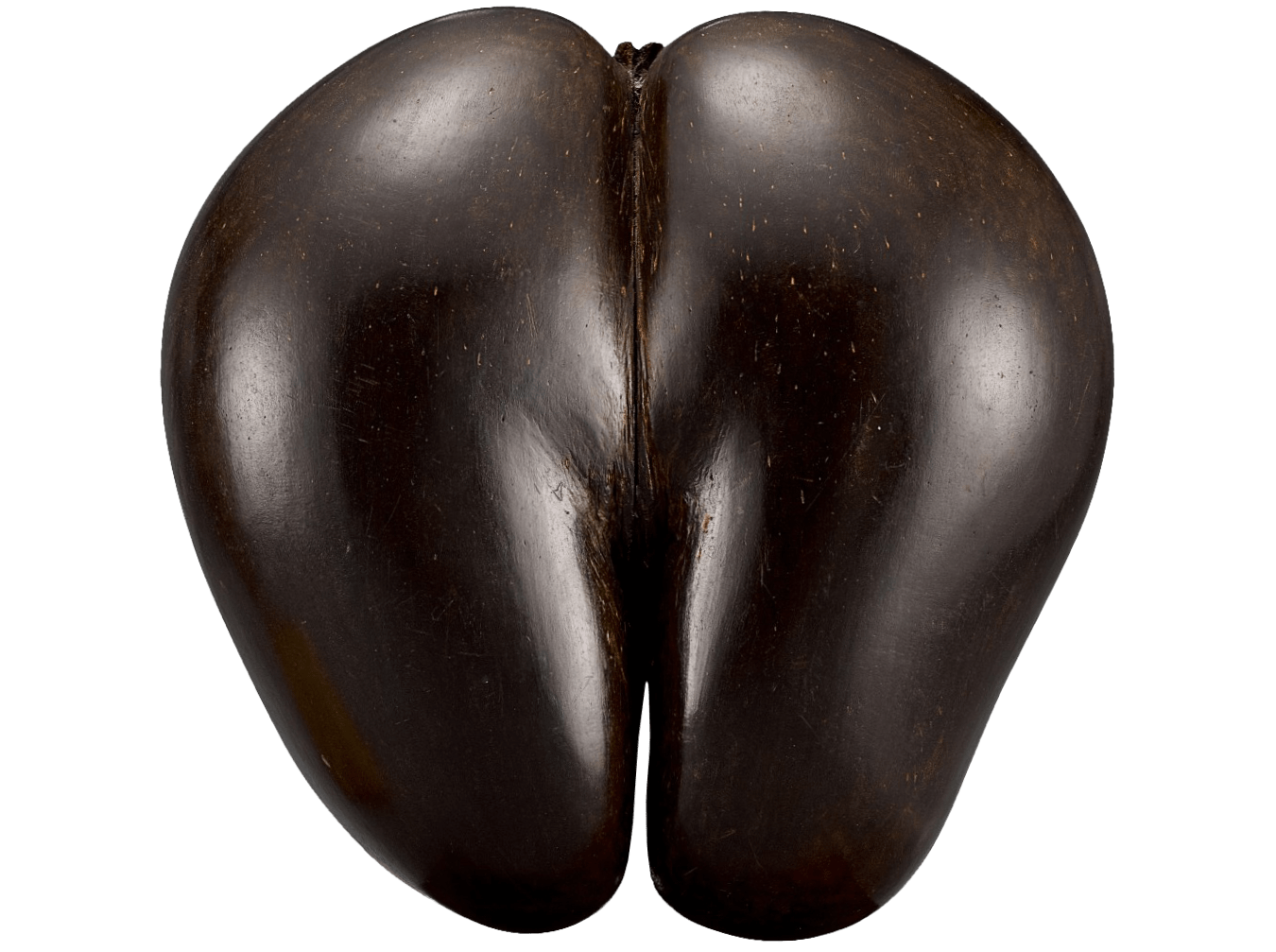


I know what this looks like, but stay with me. The Coco de Mer is more than a nut that looks like a butt.
Because let’s be honest, it really does. The unusual double seed pod of the Coco de Mer palm looks like the disembodied torso of a voluptuous woman: curves, folds, creases and all. On one side it almost perfectly resembles hips and buttocks, on the other side, thighs, belly and extremely detailed genitalia. Some specimens even sport fuzzy fibers in the ‘pubic’ region. I am not making this up. But the eroticism we project onto this entirely innocent fruit is only one reason why I've included it in the nascent category of Natural Art, objects prized and displayed as artwork for appreciation of their unique aesthetic value—the story of the coco de mer is wild, fascinating, and sad.
Let’s imagine you're a Divehi fisherman in the 15th century, returning with your catch to the Maldive archipelago. Through cerulean water you spot a dark shape hovering over the coral below. It rises, seemingly released from some deep source, and breaks the surface, glistening. You have happened upon a nearly mythological treasure, one so valued in the Maldivan Islands that you immediately head inland to present your find to the king. A coco de mer is a once in a generation find, worth more than a fully-outfitted ship, so valuable that to keep this object for yourself earns a death sentence.
...
The Coco de Mer palm is a rare and extraordinary plant. Growing to 110ft tall and bearing the largest fruits and seeds in the world, they are only found on only two tiny islands, Praslin and Curieuse, in the Seychelles archipelago in the Indian Ocean. Each tree can live as long as 800 years, but each seed takes up to a decade to ripen. From this tiny launch point, seeds that dropped into the water must ride currents more than 1300 miles before washing ashore on Maldive sands. By the time they crossed the ocean, the seeds shed their rough outer coating and lost their ability to germinate, rendering them an entirely peculiar object. Familiar, but alien, without known purpose, without known origin. A totem unshaped by human hands.
Extraordinary rarity, mysterious origin, and a viscerally recognizable shape turned the Coco de mer into a kaleidoscope of mythology and speculation. Malaysian sailors believed they came from underwater forests where the bird-monster Garuda lived. They made their way into the hands of the infant Sultan Abulmafakhir, the Holy Roman Emperor Rudolf II, and the Dutch Admiral Wolfert Hermanssen. Poets wrote of their allure, and physicians considered them a universal panacea, grinding the albumen within to cure any poison, and prescribing water kept within their hollow shells to prevent any illness.
The source of these extraordinary seeds was unknown until 1768, when the French privateer and explorer Marion du Fresne dropped a surveyor named Barre on the thickly wooded island of Praslin. Barre’s discovery was later described, “He found on the Isle de Palme, on the edge of the shore, a fruit which he first took for a coco-de-mer nut. He hid it carefully, but having penetrated in the forest he saw regretfully that the ground was covered with these fruits and with the trees which produced them.” Barre’s find was made more incredible by the discovery that coco de mer palms are dioecious plants, meaning each plant has a distinct gender, either male and female. The producers of the voluptuous seeds are, unsurprisingly, female. The male plants bear different equipment, a meter-long ‘staminate inflorescence’ that is truly alarming in its phallic heft. Again, I am not making this up.
Barre’s discovery was the beginning of the end for the legend of the coco de mer. A year later, du Fresne’s second in command visited Praslin again and sailed off with a ship full of coco de mer nuts. Radically misunderstanding supply and demand, he dumped thousands into the Indian market, destroying their rarity, their mystery, and their mythological power. While the value of the nuts plummeted, new myths were germinated. The British general Charles George Gordon claimed the island of Praslin was the actual, biblical garden of eden and that the coco de mer was the original tree of the knowledge of good and evil. As the Seychelles were settled in the 18th century, local legends sprang up that on story nights the male trees uprooted themselves to make earth-shattering coitus with the female trees—a process so wild that human witnesses were struck blind.
...
Today, the coco de mer is becoming rare again. Once covered in the towering palms, the islands of Praslin and Curieuse are now home to only six palm stands. The plants are listed on the Red List of Threatened Species, and the Seychelles government has requested that the palms and their remarkable seeds be added to the Convention on International Trade in Endangered Species (CITES list) alongside forbidden trade items like elephant ivory and rhino horn. You can, for the moment, still buy coco de mer seeds in the Seychelles, numbered and tracked souvenirs of sufficient rarity to get resold on auction sites for thousands of dollars.
Most encouraging is the initiative to put coco de mer ownership back into the hands of the Seychelles 100,000 residents, where planting-viable nuts are harvested from the Vallée de Mai and Fond Ferdinand nature reserves, and sold to Seychellois at a tenth of the tourism price on the condition they germinate and raise the palm, hopefully beginning a new 800 year cycle of the world’s most evocative fruit.
...
Got questions, comments or corrections about Coco de Mer? Join the conversation in our Discord, and if you enjoy content like this, consider becoming a member for exclusive essays, downloadables, and discounts in the Obelisk Store.
